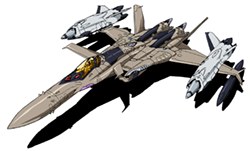Click Images For Larger View

SV-51 "Booster" In Fighter Mode (Standard Colors)
|
Sukhoi/Israel Aircraft Industries/Dornier SV-51 "Booster"
Equipment Type: variable fighter and tactical combat battroid
Government: Anti-U.N.
Manufacturer: Sukhoi/Israel Aircraft Industries/Dornier
Introduction: September 2008
Operational Deployment: September 2008
Accommodation: pilot only
Dimensions:
Fighter Mode: length 22.77 meters
Mass: unknown
Structure: SW-51 SWAG energy conversion armor
Power Plant: two Aviadvigatel D-30F6X conventional turbofan jet engines, power rating unknown (10% improvement in output over the Sukhoi S-37's D-30F6 and made from OTEC super-heat resistant, ultra lightweight space alloys)
Propulsion: 102.5 kN x 2; or 204.7 kN x 2 afterburner; 2 x VTOL high maneuverability fan jets operating as supplementary lift fan or high-maneuverability jets in Battroid mode (mounted center fuselage in Fighter mode); 2 x high-speed, high-maneuverability jet boosters equipped with Klimov RD-35A/R composite engines (with variable turbofan jet and ramjet modes), rated at 79.7 kN and 127.5 kN afterburner (159.7 kN in ramjet mode) featuring variable nozzles (mounted on overwing hard points)
Performance:
Fighter Mode: (with twin boosters) at 11,500 m Mach 3.22; cruising range (with twin boosters and standard micro-missile launcher/auxiliary tank composite pods) 1,250 km; service ceiling 22,500 m.
g limit: unknown
Design Features: 3-mode variable transformation; vertical take-off and landing; multi-axis 90 degree thrust vectoring; extending/retracting main wings; SPO-15C 360° passive radar warning receiver system; 1 x APP-60 chaff and flare dispenser system; RP-51 active stealth system; option of two high-speed, high-maneuverability jet boosters equipped with Klimov RD-35A/R composite engines featuring variable nozzles (mounted on overwing hard points); In Battroid mode, the front panel covers the field of view and serves as a wide-range screen; four-channel analog fly-by-wire (SDU-29 electronic remote control system); SBA-29 Battroid-mode control system, subordinate to the SAU-29 CNI airframe system; top and bottom vertical tails and canard wings, located behind the cockpit, function as air brakes; wings can be deployed in Battroid mode, guarantees high mobility despite drag; main wing extends/retracts for simplification, preserving strength and saving weight; in GERWALK mode, main wing folding structure is used for movement control (similar to flapping bird wings) demonstrating high-maneuverability when hovering; heavy armor in Battroid mode using energy converting armor at its maximum is used due to the enlarged body (energy capacitor performance for energy converting armor is equal to VF-0); cropped-type shield in the visor block of the head protects main camera during close-quarter combat; hovering is possible in Battroid mode
- Armament -
Guns:
1 x (2 x in SV-51γ) fixed anti-personnel/light vehicle Gsh-231 12.7mm mini-gun (mounted on port intake/hip; added starboard gun in SV-51γ)
1 x Gsh-371 55mm gun pod with 120 rounds plus one standard spare magazine stowed in special aft gun pod rack
Bombs & Missiles:
6 x underwing hard points for 4 x micro-missile launcher/auxillary tank composite pods with 18 x Turopov SA-19M I/IR-guided micro-missiles (1/point); 2 x R-33D Amos+ medium-range maneuvering missiles (1/point); when wings are folded, four of the hard points cannot be used
or a combination of above load-outs
Optional Armament:
2 x air blast bomb nicknamed "Daisy Cutter"
|
The SV-51 Booster is a minor variant of the standard variable fighter fitted with two composite engine jet boosters for increased speed and acceleration. In an unorthodox design choice, the two boosters are installed on overwing hard points and thus allows the SV-51 Booster to utilize all six underwing hard points for munitions and fuel pods. Equipped with the two Klimov RD-35A/R jet boosters, the SV-51 can achieve Mach 3.22 but at the cost of a shorter operational range. The twin boosters also boast two operational modes allowing the pilot to choose between turbofan jet and ramjet for additional propulsion.
|
Debut: Macross Zero, Episode 5
Pilot(s): Nora Polyanksy, D.D. Ivanov
Appearances: none
Original mechanical designer: Shoji Kawamori, Junya Ishigaki (cockpit) |
Information Courtesy of the Macross Compendium: www.macross.anime.net/wiki/Main_Page
Images From - Macross Zero booklet (from Macross Zero Blu-Ray Set, 2008) and other macross books
C. Wilson - Writer, Editor and Colorist
|
|
